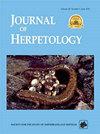The Utility of Acoustic Citizen Science Data in Understanding Geographic Distributions of Morphologically Conserved Species: Frogs in the Litoria phyllochroa Species Group
IF 0.8
4区 生物学
Q3 ZOOLOGY
引用次数: 1
Abstract
Abstract.— Understanding species' geographic distributions is important for informing their conservation; however, an accurate understanding of where species occur is often precluded by a paucity of species records. For taxa that are difficult to visually distinguish at the species level, this problem can be compounded by misidentification of existing records. Citizen science has emerged as a potentially powerful tool to increase species observation data, but whether it can meaningfully add to our understanding of the distributions of species that are typically difficult to identify is contentious. We evaluated the volume, spread, and species identification accuracy of 3 yr of data from an acoustics-based citizen science dataset with a national aggregate of species observations collected over more than 140 yr (i.e., unvouchered human observations, photo-vouchered citizen science observations, and preserved specimens) to demonstrate the boundaries of five small, morphologically conserved frog species in eastern Australia. The national aggregate contained the most species records; however, the annual rate of record collection was much greater in the acoustic citizen science dataset. A high proportion of likely misidentified records were detected in the national aggregate dataset. Spatial bias differed between datasets, with acoustic citizen science data more biased toward highly populated areas. We demonstrate that citizen science can collect large volumes of spatially and taxonomically valid data which, especially when used in combination with more traditionally collected species records, can inform the detailed delineation of ranges in historically confusing groups of frog species.声学公民科学数据在了解形态保护物种地理分布中的作用:叶序Litoria物种群中的青蛙
摘要。——了解物种的地理分布对于保护它们很重要;然而,由于缺乏物种记录,人们往往无法准确了解物种的分布。对于难以在物种层面上进行视觉区分的分类群,对现有记录的错误识别可能会加剧这一问题。公民科学已经成为增加物种观测数据的一个潜在的强大工具,但它是否能有意义地增加我们对通常难以识别的物种分布的理解,这是有争议的。我们评估了基于声学的公民科学数据集中3年数据的数量、传播和物种识别准确性,该数据集包含140多年来收集的国家物种观测结果(即未接触的人类观测结果、有照片证明的公民科学观测结果和保存的标本),澳大利亚东部形态保守的蛙类。国家总量包含了最多的物种记录;然而,声学公民科学数据集中的年度记录收集率要高得多。在国家汇总数据集中发现了很高比例的可能被误认的记录。数据集之间的空间偏差不同,声学公民科学数据更偏向于人口稠密地区。我们证明,公民科学可以收集大量空间和分类学上有效的数据,特别是当与更传统的收集物种记录结合使用时,这些数据可以为历史上令人困惑的青蛙物种群的范围的详细划定提供信息。
本文章由计算机程序翻译,如有差异,请以英文原文为准。
求助全文
约1分钟内获得全文
求助全文
来源期刊

Journal of Herpetology
生物-动物学
CiteScore
1.60
自引率
0.00%
发文量
45
审稿时长
6 months
期刊介绍:
The Journal of Herpetology accepts manuscripts on all aspects on the biology of amphibians and reptiles including their behavior, conservation, ecology, morphology, physiology, and systematics, as well as herpetological education. We encourage authors to submit manuscripts that are data-driven and rigorous tests of hypotheses, or provide thorough descriptions of novel taxa (living or fossil). Topics may address theoretical issues in a thoughtful, quantitative way. Reviews and policy papers that provide new insight on the herpetological sciences are also welcome, but they must be more than simple literature reviews. These papers must have a central focus that propose a new argument for understanding a concept or a new approach for answering a question or solving a problem. Focus sections that combine papers on related topics are normally determined by the Editors. Publication in the Long-Term Perspectives section is by invitation only. Papers on captive breeding, new techniques or sampling methods, anecdotal or isolated natural history observations, geographic range extensions, and essays should be submitted to our sister journal, Herpetological Review.
 求助内容:
求助内容: 应助结果提醒方式:
应助结果提醒方式:


